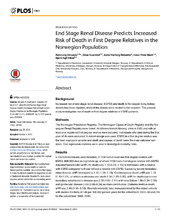| dc.contributor.author | Skrunes, Rannveig | en_US |
| dc.contributor.author | Svarstad, Einar | en_US |
| dc.contributor.author | Reisæter, Anna Varberg | en_US |
| dc.contributor.author | Marti, Hans-Petter | en_US |
| dc.contributor.author | Vikse, Bjørn Egil | en_US |
| dc.date.accessioned | 2016-12-12T12:53:59Z | |
| dc.date.available | 2016-12-12T12:53:59Z | |
| dc.date.issued | 2016-11-09 | |
| dc.Published | PLoS ONE 2016, 11(11):e0165026 | eng |
| dc.identifier.issn | 1932-6203 | |
| dc.identifier.uri | https://hdl.handle.net/1956/15233 | |
| dc.description.abstract | Background: Increased risk of end stage renal disease (ESRD) and death in Norwegian living kidney donors has been reported, most of the donors were related to the recipient. The present study investigates risk of death in first degree relatives of ESRD patients. Methods: The Norwegian Population Registry, The Norwegian Cause of Death Registry and the Norwegian Renal Registry were linked. All citizens born in Norway, alive in 1960 and with at least one registered first degree relative were included; individuals who died during the first year of life were excluded. A cohort-design was used, ESRD in a first degree relative was the main exposure variable and death and causes of death were the main outcome variables. Cox regression statistics were used to investigate mortality risks. Results: 5 130 600 individuals were included, 27 508 had at least one first degree relative with ESRD. 828 022 died during follow-up, of whom 4105 had a first degree relative with ESRD. Adjusted hazard ratio (aHR) for death was 1.13 (1.09–1.16) in individuals with a relative with ESRD compared to those without a relative with ESRD. Excluding known hereditary renal disease, aHR decreased to 1.12 (1.09–1.15). Cardiovascular death aHR was 1.15 (1.10–1.21), of which cerebrovascular death 1.34 (1.22–1.50). aHR for death due to non-hereditary renal/ureteric disease was 2.29 (1.81–2.91) with renal failure 1.80 (1.26–2.56) and glomerular disease 5.69 (3.88–8.34) as main contributors. Diabetes mellitus death aHR was 1.68 (1.35–2.10). Absolute mortality risks increased most for the oldest cohorts with excess mortality of 148 per 100.000 person years for the cohort born 1920–39 and 218 for the cohort born 1900–1919. Conclusions: ESRD in first degree relatives was associated with increased hazard ratio for death. Death due to cardiovascular disease, renal disease and diabetes mellitus increased the most. | en_US |
| dc.language.iso | eng | eng |
| dc.publisher | PLOS | eng |
| dc.relation.ispartof | <a href="http://hdl.handle.net/1956/17216" target="blank"> Hereditary renal disease in the Norwegian population, with a focus on Fabry disease</a> | |
| dc.rights | Attribution CC BY | eng |
| dc.rights.uri | http://creativecommons.org/licenses/by/4.0 | eng |
| dc.title | End Stage Renal Disease Predicts Increased Risk of Death in First Degree Relatives in the Norwegian Population | en_US |
| dc.type | Peer reviewed | |
| dc.type | Journal article | |
| dc.date.updated | 2016-11-10T10:16:17Z | |
| dc.description.version | publishedVersion | en_US |
| dc.rights.holder | Copyright 2016 The Author(s) | |
| dc.identifier.doi | https://doi.org/10.1371/journal.pone.0165026 | |
| dc.identifier.cristin | 1398976 | |

